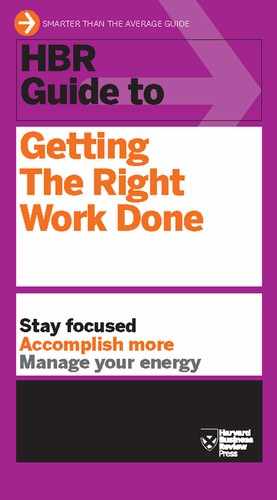Chapter 12
To-Do Lists That Work
by Gina Trapani
Here’s how to write to-do lists that work:
- Break it down. Take a task and carve it into bite-sized chunks. Then break it down some more. Don’t confuse to-do’s with goals or projects. A to-do is a single, specific action that will move a project toward completion. It’s just one step. For example, “Plan the committee lunch” is a project. “E-mail Karen to get catering contact” is a to-do.
Breaking down your task into the smallest possible actions forces you to think through each step up front. With the thinking out of the way, it’s easy to dash off that e-mail, make that call, or file that report, and move your work along with much less resistance.
- Use specific action verbs and include details You’re overdue for a check-in with your mentor, but the “Lunch with Judy” to-do just hasn’t gotten done. When you write down that task, use an action verb (call? e-mail?) and include whatever details your future self needs to check it off. “Call Judy at 555-4567 for lunch on January 17, 18, or 19” is a specific, detailed to-do.
Make your to-do’s small and specific to set yourself up for that glorious moment when you can cross them off your list as DONE.
Here are some more tips for effective to-do lists from the hbr.org community.
- Bucket your work in any way that makes sense for you (for example, work/home/freelance); by area of responsibility (Smith account/Culver account/web team); by difficulty level (group all of your “easy” five-minute tasks together so when you have spare time, you can quickly spot them and knock a few off). Give each bucket its own column.
- Deliberately use a small-trim book or paper (6” × 9”) to keep your list short or a distinctive size (like an 8.5” × 11” piece of paper folded in half) that makes it stand out from other papers you carry.
- Make a two-view list. Two lists, with the same to-do’s, but one organized by buckets, one by week. Bonus: You get the joy of crossing off one task in TWO places.
- Pick a medium that works for you: a notebook you love (for example, Moleskine); a web-based app that syncs on your mobile and computer, wherever you are; your mobile’s voice-memo function.
- Make notes in the margin or beside an item to mark when it’s due (M or 2/16).
- Highlight your top-priority items or put a bright-colored sticky with your top three things to do for the day on top of your longer list/buckets.
- Build in rewards. For example, for every three things you cross off your work list, allow yourself to do one home/personal task; or for every one difficult work task you accomplish, reward yourself with three easy or fun work ones.
- Rewrite your list every other day or so to help you reprioritize.
- When a task is done, check off a box or cross off the item with a fat marker—whatever gives you the most satisfaction.
____________
Gina Trapani is the founding editor of the personal productivity blog Lifehacker.com.
______________
Adapted from content posted on hbr.org on January 13, 2009.
..................Content has been hidden....................
You can't read the all page of ebook, please click here login for view all page.
